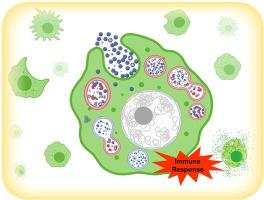Advanced Drug Delivery Reviews ( IF 15.2 ) Pub Date : 2021-11-02 , DOI: 10.1016/j.addr.2021.114022 Raziye Mohammapdour 1 , Hamidreza Ghandehari 2

|
Careful assessment of the biological fate and immune response of inorganic nanoparticles is crucial for use of such carriers in drug delivery and other biomedical applications. Many studies have elucidated the cellular and molecular mechanisms of the interaction of inorganic nanoparticles with the components of the immune system. The biodegradation and dissolution of inorganic nanoparticles can influence their ensuing immune response. While the immunological properties of inorganic nanoparticles as a function of their physicochemical properties have been investigated in detail, little attention has been paid to the immune adverse effects towards the degradation products of these nanoparticles. To fill this gap, we herein summarize the cellular mechanisms of immune response to inorganic nanoparticles and their degradation products with specific focus on immune cells. We also accentuate the importance of designing new methods and instruments for the in situ characterization of inorganic nanoparticles in order to assess their safety as a result of degradation. This review further sheds light on factors that need to be considered in the design of safe and effective inorganic nanoparticles for use in delivery of bioactive and imaging agents.
中文翻译:

无机纳米颗粒及其降解产物的免疫反应机制
仔细评估无机纳米颗粒的生物命运和免疫反应对于此类载体在药物输送和其他生物医学应用中的使用至关重要。许多研究已经阐明了无机纳米颗粒与免疫系统成分相互作用的细胞和分子机制。无机纳米粒子的生物降解和溶解可以影响其随后的免疫反应。虽然已经详细研究了无机纳米粒子的免疫学特性作为其物理化学特性的函数,但很少关注这些纳米粒子的降解产物的免疫不利影响。为了填补这一空白,我们在此总结了对无机纳米颗粒及其降解产物的免疫反应的细胞机制,特别关注免疫细胞。我们还强调设计用于无机纳米颗粒原位表征的新方法和仪器的重要性,以评估其降解后的安全性。该综述进一步阐明了在设计用于递送生物活性剂和显像剂的安全有效的无机纳米粒子时需要考虑的因素。









































 京公网安备 11010802027423号
京公网安备 11010802027423号